 Pirates and Privateers Pirates and Privateers
The History of Maritime
Piracy
Cindy Vallar, Editor
& Reviewer
P.O. Box 425,
Keller, TX 76244-0425
    
Transformation
A Family Affair
  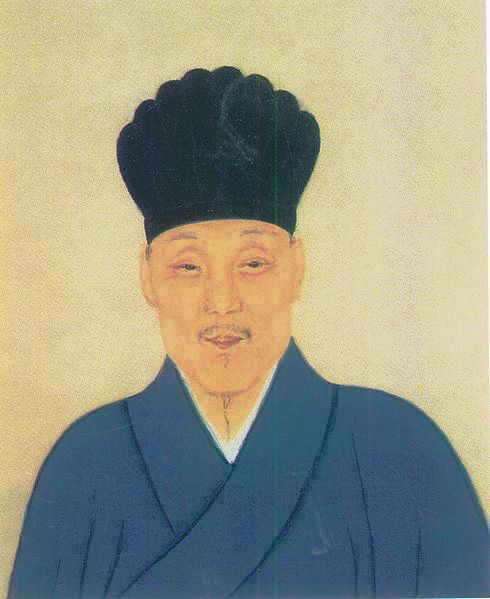 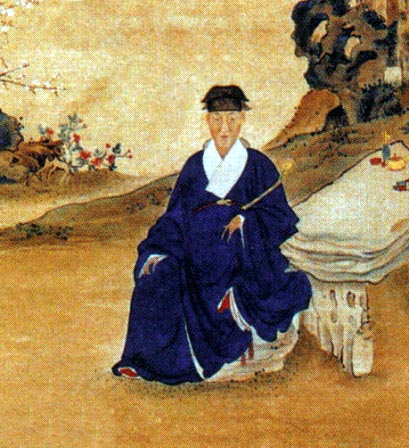
Left to right: Zheng
Zhilong (father), Koxinga (son), Zheng Jing
(grandson), and Zheng Keshuang (great-grandson)
(Source: Wikimedia Commons ZZ, K, ZJ, ZK)
Change is inevitable. From the
time we are born until the day we die, we
are changing. The catalysts of change may
be external or internal, and the result
may be good or bad. Such is the cycle of
life. In adolescence, we test boundaries.
We prepare to change from a child to an
adult. We adopt some behaviors and discard
others, depending on how others react,
what we learn, and how we feel.
As time passes, piracy changes. It is also
cyclical. Philip
Gosse, a physician and naturalist
with an avid interest in pirates,
describes this cycle in The History of
Piracy.
First a few individuals from
amongst the inhabitants of the poorer
coastal lands would band together in
isolated groups owning one or but a
very few vessels apiece and attack
only the weakest of merchantmen. They
possessed the status of outlaws whom
every law abiding man was willing and
eager to kill at sight. Next would
come the period of organization, when
the big pirates either swallowed up
the little pirates or drove them out
of business. These great organizations
moved on such a scale that no group of
trading ships, even the most heavily
armed, was safe from their attack. . .
.
Then came
the stage when the pirate
organization, having virtually reached
the status of an independent state,
was in a position to make a mutually
useful alliance with another state
against its enemies. What had been
piracy then for a time became war, and
in that war the vessels of both sides
were pirates to the other . . ..
In the end
the victory of one side would as a
rule break up the naval organization
of the other . . .. The component
parts of the defeated side would be
again reduced to the position of
outlaw bands, until the victorious
power was strong enough to send them
scurrying back once more to the status
of furtive footpads of the sea whence
they had arisen. (1-2)
Sound a bit
familiar? Gosse could have been describing
the Zheng clan’s rise to power. When
Koxinga died, they were on the cusp of
achieving “the status of an independent
state.” Zheng Zhilong’s success bred
legitimacy. Koxinga’s seizure of Taiwan
from the Dutch created the seed from which
an “independent state” might rise. His
son, Zheng Jing, would nurture that
genesis into near reality . . . although
not many thought him capable of doing so
after his father’s death.
 Koxinga and his wife, Dong
Cuiying, welcomed their first son
into the world in 1642. They named him
Zheng Shifan (Model for the World),
although during his childhood, he was
usually called Jin-She (Bright Prospect
for the House). He tended to follow the
beat of his own drummer rather than
heeding his parents. He did so in ways
that suggested that he had little
backbone. He tended to follow his
emotions, which apparently appealed to
women, especially those who were older. He
also liked to drink, sometimes to excess. Koxinga and his wife, Dong
Cuiying, welcomed their first son
into the world in 1642. They named him
Zheng Shifan (Model for the World),
although during his childhood, he was
usually called Jin-She (Bright Prospect
for the House). He tended to follow the
beat of his own drummer rather than
heeding his parents. He did so in ways
that suggested that he had little
backbone. He tended to follow his
emotions, which apparently appealed to
women, especially those who were older. He
also liked to drink, sometimes to excess.
Shortly before his death, Koxinga
discovered that Zheng Jing was having a
fling with his younger siblings’ wet nurse
(Lady Chen). This affair resulted in the
birth of his first grandson, Zheng Kezang.
Koxinga went ballistic. He ordered Zheng
Jing’s execution. That did not happen,
perhaps because of Koxinga’s untimely
passing at the age of thirty-eight or
because two men, granduncle Zheng Tai and
longtime Zheng associate Hong Xu,
safeguarded him in Fujian.
Now that Koxinga was dead, who was to
become the next head of the family
business and rule Taiwan? Zheng Jing was
the obvious choice as eldest son, but
rumors said that Koxinga had sworn before
witnesses that he wanted his second son to
rule instead. The Taiwan waiji
says Koxinga’s choice was his younger
brother, Zheng Shixi, not his second son.
There were other family members who felt
they had stronger claims to succeed
Koxinga, especially given the rebellious
and wayward behavior of Zheng Jing, who
believed he was the rightful heir.
The first of these family members was
Zheng Tai, Koxinga’s uncle. While his
nephew was out fighting for the Ming
emperor, Zheng Tai oversaw the running of
the family business. Father Victorio
Riccio, a Dominican missionary from the
Philippines, said Zheng Tai “occupied the
primary and almost absolute post of
government since Cuesing’s (Koxinga’s)
death.” (Blussé, 230)
What was evident was that relationships
within the Zheng clan were not as smoothly
woven as the threads of their red silk
banner. These filaments were snapping and
discord was inevitable. Perhaps this was
why Zheng Jing took stock of his life and
found it wanting. Whatever catalyst made
him switch paths from rebellious
adolescent to a more rational adult, this
happened. As had occurred with his father
and grandfather, it was a moment when he
lacked sufficient resources to openly take
on his granduncle. Subtler means were
needed. First, he would watch and learn.
While Zheng Tai controlled the family’s
mainland holdings, the man who wielded the
power on Taiwan was Ma Xin, Koxinga’s
second-in-command. The two men did not
agree and the fissure dividing them only
widened when the Qing invited Zheng Tai to
discuss peace. He was open to this, even
though the olive branch being offered was
more severe than in the past. First, the
Zheng must leave all their bases in China.
Second, the men had to shave the front of
their heads
and wear what remained of their hair in a
long
braid down their back just as the
Manchu did. Only then would it be possible
to receive a high-ranking position and/or
special privileges.
_(14580605068).jpg)
Samples of Manchu queues
from Adolf Rosenberg's and Eduard
Heyck's Geschichte des Kostüms,
1905
(Source: Wikimedia
Commons)
Zheng Tai didn’t bother to consult with
his grandnephew or Ma Xin. He and the
other Zheng commanders in Xiamen would
agree. To show his seriousness in
accepting these conditions, he turned over
a few Zheng seals; in return, the Qing
would name him lawful head of the Zheng
organization. When Zheng Jing learned of
this, he was powerless to intervene and
went with the flow. Ma Xin, however,
severed connections between the island and
Xiamen and announced that Taiwan would now
institute its own government. There was
just one minor problem: the island had a
ruler named Zheng Xi. He might be just a
figurehead, but he was the tenth brother
of Koxinga and was in collusion with Zheng
Tai.
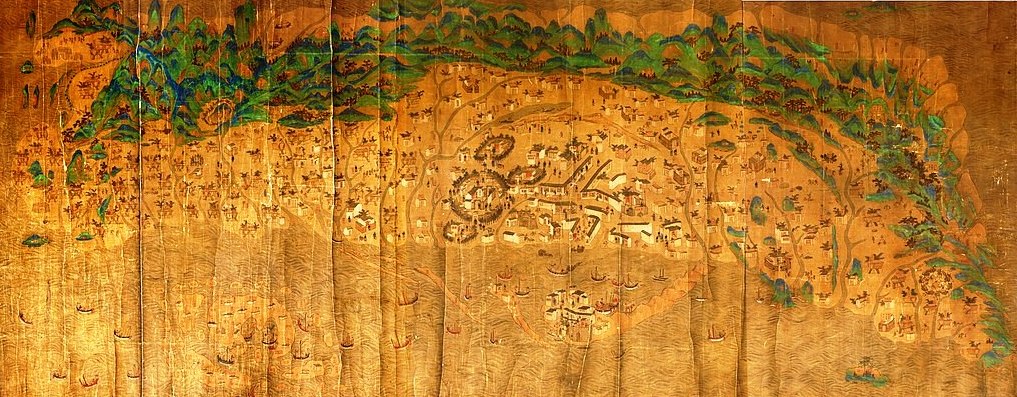
Scroll painting of
Taiwan during Kangxi era, 1684-1722 by
unknown artist
(Source: Wikimedia
Commons)
Zheng Xi, with the assistance of two
generals, decided it was time to terminate
Ma Xin. Once that man was out of the way,
another problem cropped up; they no longer
had any need of Zheng Jing. As they
determined how best to get rid of him and
what might be a plausible reason for doing
so, Zheng Tai found himself in trouble
because Ma Xin was dead. To placate other
members of the extended family, Zheng Tai
reevaluated his submission plans to the
Qing.
One commander in Xiamen was troubled by
Zheng Tai’s maneuverings without
consulting anyone. Hong Xu had been with
the family for more than thirty years; he
had worked alongside Zheng Zhilong in the
early days. Now Hong Xu decided it was
better to back the grandson and provided
Zheng Jing with the ships and soldiers he
needed to gain control over the family
enterprises. First objective: free Taiwan
of anyone colluding with his granduncle.
Once those men ceased to exist, the
remaining officers on the island
acknowledged that Zheng Jing was the
rightful heir to the Zheng enterprises.
During this first visit to Taiwan, Zheng
Jing unearthed correspondence between the
colluders and Zheng Tai. One letter,
written by Zheng Tai, said that if Zheng
Jing tried to gain control of the island,
Zheng Xi should make certain their
grandnephew died. If Zheng Jing wanted to
live a long and happy life, he had to deal
with his rival once and for all. Although
he and his men returned to Xiamen toward
the end of January 1663, it was not the
right time to confront Zheng Tai.
In July, there was to be a family
gathering and Zheng Tai accepted his
invitation. Father Riccio recorded what
happened.
[T]he son of the deceased
Cuesing [Koxinga] . . . during a
banquet treacherously arrested the
senior mandarin, Chuye [Zheng Tai],
the most powerful and richest man
there was in Imperial China. . . .
Chuye therefore hanged himself in his
cell the following day, grieved and
enraged at being mocked by a brigand,
and depressed over his ill fortune.
The land and the seas fell into chaos
at this tragic news because Chuye was
loved by all. (Blussé, 231-232)
Another
account, written by a Dutch official in
1665, chronicled what he had seen and
heard. (In this version of events, he
referred to Zheng Jing as “Kimtsia” and
Zheng Tai as “Sauja.” Formosa was Taiwan.)
Kimtsia saw that the hour of
his revenge had come and during the
banquet produced the letter and showed
it to Sauja, asking him if he was
familiar with it and had written it.
Sauja did not flinch and answered that
he had. He told him the motives that
had induced him to write it.
Thereupon
Kimtsia had his men seize the aged
man, had him thrown into prison and
strangled with a cord. A trusted
servant of Sauja who was present
managed to escape in the commotion . .
. carrying the sad news of this murder
to . . . Sauja’s brother. (Blussé,
234)
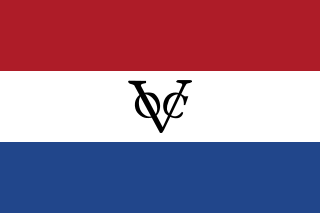 Many family members,
including the brother, and those who had
supported Zheng Tai decided their chances
of survival were better if they submitted
to the Qing rather than Zheng Jing. Zheng
Tai’s brother took with him “180 junks,
and over ten thousand soldiers.” (Hang,
150) The Qing couldn’t ask for a better
gift. The time had come to seize control
of Xiamen and Jinmen, two Zheng
strongholds. They also formed an alliance
with the Vereenigde Oostindische
Compagnie (VOC, or Dutch East India
Company), which had suffered such
humiliation at the hands of Koxinga. Many family members,
including the brother, and those who had
supported Zheng Tai decided their chances
of survival were better if they submitted
to the Qing rather than Zheng Jing. Zheng
Tai’s brother took with him “180 junks,
and over ten thousand soldiers.” (Hang,
150) The Qing couldn’t ask for a better
gift. The time had come to seize control
of Xiamen and Jinmen, two Zheng
strongholds. They also formed an alliance
with the Vereenigde Oostindische
Compagnie (VOC, or Dutch East India
Company), which had suffered such
humiliation at the hands of Koxinga.
On 19 November, the allies launched their
offensive. The combined fleet pitted
seventeen Dutch ships and 500 Qing junks
against Zheng Jing’s 400 vessels. Although
his men slew the Qing commander, there was
little he could do against 400 Dutch guns
and troops exceeding 2,500. This presented
Zheng Jing with two options: submit and
conform, or flee and live in exile
forever. Zheng Tai, with what remained of
his ships (at most fifty) and 4,000
officers and men as well as kindred of the
Ming imperial family, opted for exile and
left their homeland in April 1664.
Resources on Taiwan were limited; during
the siege against the Dutch, Koxinga had
run into trouble feeding the 25,000
soldiers already occupying the island. Nor
were they the only ones living there;
aborigines were present and they weren’t
particularly welcoming. Unlike his father,
who liked to oversee everything, Zheng
Jing preferred to seek advice. He
established a council of advisors, led by
his friend Chen Yonghua. Together, they
implemented policies, some of which
originated with Koxinga, to create a
viable agrarian system that, in turn,
resulted in some manufacturing that
allowed the island to become self-reliant
to a limited degree.
Next, Zheng Jing focused his attention on
reviving Zheng operations. Illicit trading
centers were established on unoccupied
islands. He bribed Qing officers and
officials, which allowed him access to
luxuries like silk. These items, along
with sugar and deerskins from Taiwan, were
then traded in Japan. Once the Zheng
business flourished once again, he was
able to branch further afield and trade
with foreigners.
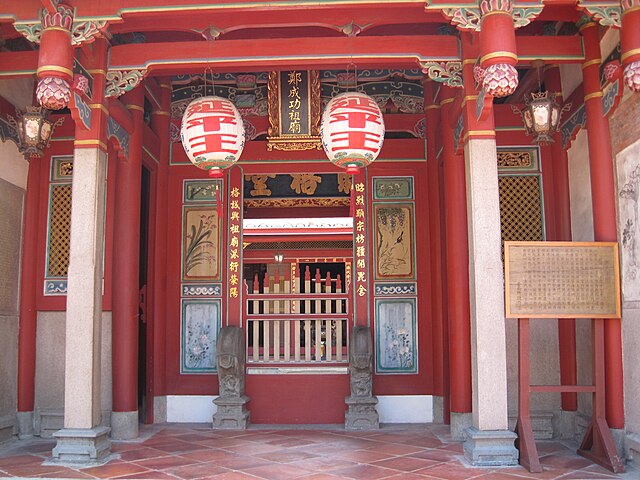 He also developed
infrastructure and built temples and
shrines. Schools that promoted the values
of Confucius opened. Teachers went out to
work with the aborigines, instructing them
on better ways to farm and providing them
with the necessary implements and animals.
At the same time, he downplayed symbols
related to the Ming dynasty. He also
placed restrictions on members of the
gentry with strong ties to the old ways
who saw him as weak and ineffective. He also developed
infrastructure and built temples and
shrines. Schools that promoted the values
of Confucius opened. Teachers went out to
work with the aborigines, instructing them
on better ways to farm and providing them
with the necessary implements and animals.
At the same time, he downplayed symbols
related to the Ming dynasty. He also
placed restrictions on members of the
gentry with strong ties to the old ways
who saw him as weak and ineffective.
Like his father, Zheng Jing wrote poetry.
One poem, “Ti Dongning shengjing,”
described Taiwan and his desire to
preserve some traditions.
I have established a court,
and settled a capital, east of the
great sea,
A myriad
mountains and a plethora of valleys
are in the distance, crossing the sky.
Scented
forests rise high up into the clouds,
Green
waters flow along to gather in emerald
pools.
On both
banks fires are lit to welcome the
rising sun,
Across the
river the oars of the fishermen dip
against the dawn breeze.
In the past
I studied the words of the sage about
dealing with trouble.
The caps
and gowns of Han states have remained
the same since antiquity.
(Milburn, 67)
In another
poem, he shared his thoughts on the Manchu
invasion. He was two years old when the
Ming dynasty fell, and the upheaval that
followed impacted his life.
A foul and rank stench fills
the Central Plains,
The trees
in our forests provide nests for
foreign birds.
The Son of
Heaven has fled in a cloud of dust;
Everyone
complains of his minsters’ crimes.
(How right is this
criticism!)
Strong
knights cherish [dreams of] bravery
and heroism,
Their loyal
hearts are fixed on a single goal.
The banners
of these righteous warriors can be
seen across the land,
In the
endless parade, they cover the sun.
Those who
suffer in vain are the common folk,
For the
plans that are made are indeed not the
best.
One day,
the barbarian horsemen arrive;
Everyone
betrays [the Ming] for their own
personal benefit.
I am today
raising a royal army,
I will
punish the guilty – justice will be
done for the people.
I am
training up ferocious soldiers,
Building up
their strength on this eastern island.
I have been
hoping that the Green Phoenix will
arrive;
But even
after all these years, it still has
not appeared.
(Milburn,
73-74) (see notes 1, 2)
Despite his
dislike of the Qing, Zheng Jing understood
he needed them to recognize his government
on Taiwan as being legitimate. The one
sticking point in these negotiations, as
always, involved the Qing’s insistence on
adoption of their hairstyle. After two
years with no compromise found, each side
went back to their own corners. The Qing
did, however, become more tolerant of
Zheng presence on the island and upon the
seas.
During this time, Japan continued to send
tribute ships to the Qing to keep trade
open between the two countries. In 1670, a
Zheng junk seized one of these vessels and
its crew was slain. Two years later, when
a Zheng ship put in at Nagasaki, officials
seized its cargo. When Zheng Jing learned
of this, he banned all Japanese vessels
from docking in Taiwan. A shipwrecked
Japanese sailor was arrested and forced to
live and work for a peasant. Since trade
relations between Japan and the Zheng went
back at least to his grandfather’s
days, some saw this as counterproductive,
even risky. His interpretation was another
indicator in the stage of the piracy cycle
that Zheng Jing had achieved. His actions
“expressed his readiness to defend his
subjects from foreign rulers’ mistreatment
and unjust seizure of their property, to
the point of foregoing the lucrative
profits from trade.” (Hang, Bridging, 245)
Another indication of this stage involved
Zheng trading partners. He wanted Taiwan
to become a major player and act as a
gateway for international trade. No longer
would they rely just on goods from China
and Japan. They would trade with the
English, the Philippines, and other
countries of Southeast Asia.
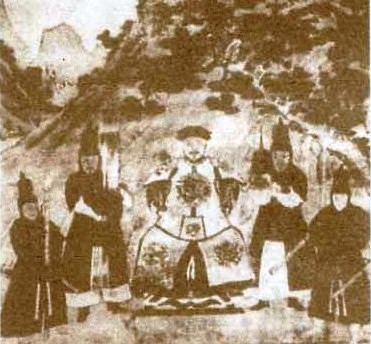 In the early days of the
Qing dynasty, the emperor had given three
Ming defectors control of three regions
and, over the years, these feudal lords
pretty much had free reign in how they
ruled. The problem was that they were
becoming too powerful and the Kangxi
emperor wanted to curtail their power.
They did not take kindly to such
intervention and in 1673, rose up against
the emperor in what became known as the
Revolt of the Three Feudatories. One of
these feudal lords was Wu
Sangui, with whom Zheng Jing had
corresponded three years earlier. In the early days of the
Qing dynasty, the emperor had given three
Ming defectors control of three regions
and, over the years, these feudal lords
pretty much had free reign in how they
ruled. The problem was that they were
becoming too powerful and the Kangxi
emperor wanted to curtail their power.
They did not take kindly to such
intervention and in 1673, rose up against
the emperor in what became known as the
Revolt of the Three Feudatories. One of
these feudal lords was Wu
Sangui, with whom Zheng Jing had
corresponded three years earlier.
Every time I read Your
Highness’s letters, proclamations, and
drafts, I never fail to clap my hands
and sigh at the intensity of your
loyalty and filial piety, and am often
moved to tears afterward. Looking out
across the Four Seas, we all place
[hope] in Your Highness. During your
spare time outside of administration
and military affairs, are you familiar
with this solitary minister beyond the
pale? . . . Although my humble country
is small, I have a thousand war junks
and ten thousand warriors only for
Your Highness to use. I await your
virtuous reply from afar. (Hang, Conflict,
190)
It wasn’t that
Zheng Jing was eager to fight the Qing,
but he thought if he allied with Wu Sangui
and they were successful, then Wu Sangui
could grant him the legitimacy that he
wanted for Taiwan. Although his offer was
declined then, Wu Sangui and the other two
feudal lords accepted it in 1674, and
Zheng Jing returned to Fujian and
Guangdong. He composed a poem that
explained why he and the feudal lords
fought the Qing.
Floating away to campaign in
the west, riding on a battle-ship,
I sing
loudly when the oars strike as we
cross the waters.
The proper
destiny of the country will be
restored today,
The evil
influences of the barbarian caitiffs
will now be extirpated.
The common
people shout with joy at the
restoration of the Han house,
Exiled
ministers are delighted as they get to
gaze upon this sacred land.
After ten
years of training and preparation, now
is the time to act,
How could a
valiant knight refuse to cross the
seas this autumn?
(Grand and proud)
(Milburn,
80-81)
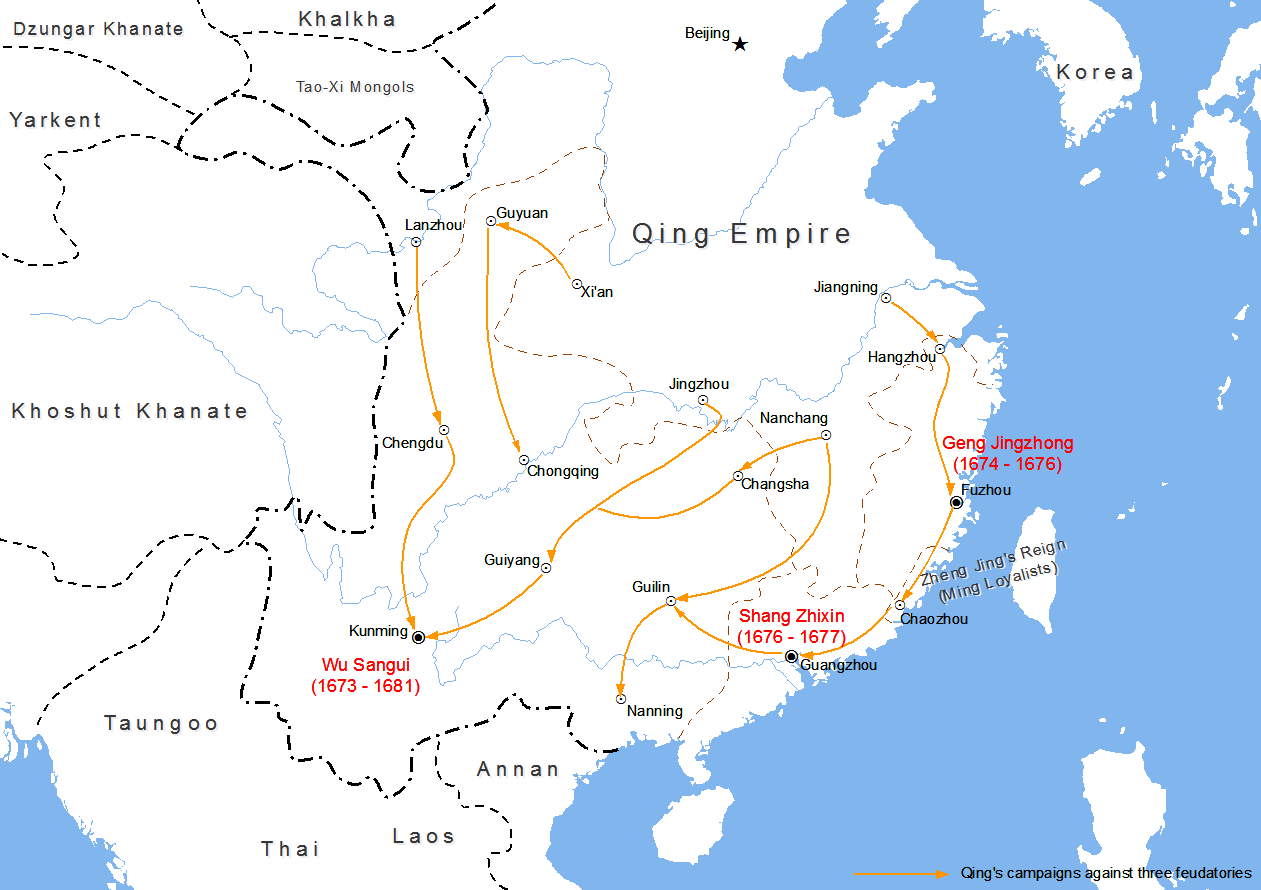
Map of the Revolt of the
Three Feudatories by SY, 2017
(Yellow arrows denote Qing campaigns)
(Source: Wikimedia
Commons)
His successes between 1675 and 1680
resulted in former Zheng adherents
rethinking their submissions to the Qing
and coming back into the fold. Eventually,
a problem developed. He was too far from
his base in Taiwan, which could not
provide him with needed supplies. In the
end, he turned to a piratical tactic:
plundering.
 The Kangxi
emperor and his army would not
surrender. Slowly, the tide turned and the
three feudal lords found themselves in
dire straits. Two surrendered. Dysentery
claimed Wu Sangui in 1680. Zheng Jing and
his men returned to Taiwan. Unfortunately,
many of those who were closest to him,
including his friend Chen Yonghua, died
shortly thereafter. Devastated by the
losses of these men whose counsel he so
valued, Zheng Jing reverted to his old
ways. He drank too much and spent much of
his time with women. These overindulgences
led to his death the following year. He
was only thirty-nine, a year older than
Koxinga was when he died. The Kangxi
emperor and his army would not
surrender. Slowly, the tide turned and the
three feudal lords found themselves in
dire straits. Two surrendered. Dysentery
claimed Wu Sangui in 1680. Zheng Jing and
his men returned to Taiwan. Unfortunately,
many of those who were closest to him,
including his friend Chen Yonghua, died
shortly thereafter. Devastated by the
losses of these men whose counsel he so
valued, Zheng Jing reverted to his old
ways. He drank too much and spent much of
his time with women. These overindulgences
led to his death the following year. He
was only thirty-nine, a year older than
Koxinga was when he died.
Zheng Jing’s eldest son, Zheng Kecang,
succeeded him, but Koxinga’s wife, Dong
Cuiying, loathed this grandson because she
considered him of low birth since his
mother had only been a wet nurse. She felt
Zheng Jing’s next oldest son was more
deserving to rule of Taiwan. Two days
after Zheng Jing’s death, she summoned
Zheng Kecang to her apartment and
strangled him.
 Zheng Keshuang assumed the
throne. Since he was only eleven years
old, his eldest uncle served as regent. In
1683, the Kangxi emperor decided it was
time to put an end to the Zheng once and
for all. To that end, he appointed Shi
Lang to effect that goal. Shi Lang was a
creative general who often tried new
approaches to achieve what he desired and
he was quite successful in doing so. He
had also once served Koxinga,
until irreparable differences resulted in
Shi Lang’s defection. Now he intended to
wipe out the Zheng fleet and force Zheng
Keshuang to submit. Zheng Keshuang assumed the
throne. Since he was only eleven years
old, his eldest uncle served as regent. In
1683, the Kangxi emperor decided it was
time to put an end to the Zheng once and
for all. To that end, he appointed Shi
Lang to effect that goal. Shi Lang was a
creative general who often tried new
approaches to achieve what he desired and
he was quite successful in doing so. He
had also once served Koxinga,
until irreparable differences resulted in
Shi Lang’s defection. Now he intended to
wipe out the Zheng fleet and force Zheng
Keshuang to submit.
He achieved both goals and those who
survived were forced to discard their
weapons and move far inland in China. Some
warriors, adept at their jobs, were
permitted to retain their weapons and
fight, but they did so in Manchuria
against the Russians. Other followers
resumed their former lives, returning to
the first stage in the piracy cycle, this
time in the Gulf of Tonkin.
Zheng Keshuang cut his hair and dressed as
the Qing did. He lived in Beijing, where
he was named Duke Who Quells the Seas, one
of several honorary titles he received. In
1684, the Kangxi emperor lifted the last
sea bans and even permitted foreigners to
come into Chinese ports to trade.
Piracy continued to be a pursuit of those
who had allied with the Zheng. In the
early years of the nineteenth century,
another Zheng would rise to the forefront
of Chinese history. (see note 3) He
and his
wife would establish a pirate
confederation that rivaled the imperial
navy and controlled the waters around the
same coast as Zheng Zhilong and his
family.
Notes:
1. The Green Phoenix was
the rightful emperor.
2. The boldfaced lines within
parentheses are comments that appeared in
the earliest published book containing the
poems. Most likely, Zheng Jing oversaw
this edition; he may have penned these
(comments) himself.
3. Zheng Yi was the
son of Zheng Liaching, whose
great-grandfather, Zheng Qián (Cheng
Chien), joined Koxing soon after moving to
Fujian in 1641. He served as an officer in
Koxinga's army. Although he eventually
returned to farming, some of his offspring
and their descendants chose piracy as
their calling.
Resources:
Anderson, John L. "Piracy and
World History: An Economic Perspective
on Maritime Predation," Bandits at
Sea: A Pirates Reader edited by C.
R. Pennell. New York University, 2001,
82-106.
Andrade, Tonio, and Xing Hang. “The East
Asian Maritime Realm in Global History,
1500-1700,” Sea Rovers, Silver, and
Samurai: Maritime East Asia in Global
History, 1550-1700. University of
Hawai'i, 2019, 1-27.
Antony,
Robert J. Like Froth Floating on the
Sea: The World of Pirates and
Seafarers in Late Imperial South China.
Institute of East Asian Studies,
University of California, 2003.
Blussé, Leonard. “Shame and Scandal in
the Family: Dutch Eavesdropping in the
Zheng Lineage,” Sea Rovers, Silver,
and Samurai: Maritime East Asia in
Global History, 1550-1700.
University of Hawai’i, 2019, 226-237.
Clements, Jonathan. Coxinga and the
Fall of the Ming Dynasty. Sutton,
2005.
Emmer, Pieter C., and Joseph J. L.
Gommans. The Dutch Overseas Empire,
1600-1800 translated by Marilyn
Hedges. Cambridge University, 2021.
Gosse, Philip. The History of Piracy.
Rio Grande Press, 1995.
Hang Xing. “Bridging the Bipolar: Zheng
Jing’s Decade on Taiwan, 1663-1673,” Sea
Rovers, Silver, and Samurai: Maritime
East Asia in Global History, 1550-1700.
University of Hawai’i, 2019, 238-259.
Hang Xing. Conflict and Commerce in
Maritime East Asia: The Zheng Family
and the Shaping of the Modern World,
c. 1620-1720. Cambridge
University, 2017.
Hang Xing. “The Contradictions of
Legacy: Reimaging the Zheng Family in
the People’s Republic of China,” Imperial
China 34:2 (December 2013), 1-27.
Konstam, Angus. Piracy: The Complete
History. Osprey, 2008.
Milburn, Olivia. “Representations
of History in the Poetry of Zheng Jing,”
Ming Qing Yanjiu 21 (2017),
58-92.
Murray, Dian H. Pirates of the South
China Coast 1790-1810. Stanford
University, 1987.
Xu Ke.
“Piracy, Seaborne Trade and the
Rivalries of Foreign Sea Powers in East
and Southeast Asia, 1511 to 1839: A
Chinese Perspective” in Piracy,
Maritime Terrorism and Securing the
Malacca Straits edited by Graham
Gerard Ong-Webb. International Institute
for Asian Studies and the Institute of
Southeast Asian Studies, 2006.
Copyright ©2023 Cindy Vallar

Click to contact me
Background image compliments
of Anke's Graphics |





 Koxinga and his wife,
Koxinga and his wife, _(14580605068).jpg)

 Many family members,
including the brother, and those who had
supported Zheng Tai decided their chances
of survival were better if they submitted
to the Qing rather than Zheng Jing. Zheng
Tai’s brother took with him “180 junks,
and over ten thousand soldiers.” (Hang,
150) The Qing couldn’t ask for a better
gift. The time had come to seize control
of Xiamen and Jinmen, two Zheng
strongholds. They also formed an alliance
with the Vereenigde Oostindische
Compagnie (VOC, or Dutch East India
Company), which had suffered such
humiliation at the hands of Koxinga.
Many family members,
including the brother, and those who had
supported Zheng Tai decided their chances
of survival were better if they submitted
to the Qing rather than Zheng Jing. Zheng
Tai’s brother took with him “180 junks,
and over ten thousand soldiers.” (Hang,
150) The Qing couldn’t ask for a better
gift. The time had come to seize control
of Xiamen and Jinmen, two Zheng
strongholds. They also formed an alliance
with the Vereenigde Oostindische
Compagnie (VOC, or Dutch East India
Company), which had suffered such
humiliation at the hands of Koxinga. In the early days of the
Qing dynasty, the emperor had given three
Ming defectors control of three regions
and, over the years, these feudal lords
pretty much had free reign in how they
ruled. The problem was that they were
becoming too powerful and the Kangxi
emperor wanted to curtail their power.
They did not take kindly to such
intervention and in 1673, rose up against
the emperor in what became known as the
Revolt of the Three Feudatories. One of
these feudal lords was
In the early days of the
Qing dynasty, the emperor had given three
Ming defectors control of three regions
and, over the years, these feudal lords
pretty much had free reign in how they
ruled. The problem was that they were
becoming too powerful and the Kangxi
emperor wanted to curtail their power.
They did not take kindly to such
intervention and in 1673, rose up against
the emperor in what became known as the
Revolt of the Three Feudatories. One of
these feudal lords was 
 The
The  Zheng Keshuang assumed the
throne. Since he was only eleven years
old, his eldest uncle served as regent. In
1683, the Kangxi emperor decided it was
time to put an end to the Zheng once and
for all. To that end, he appointed Shi
Lang to effect that goal. Shi Lang was a
creative general who often tried new
approaches to achieve what he desired and
he was quite successful in doing so. He
had also once served
Zheng Keshuang assumed the
throne. Since he was only eleven years
old, his eldest uncle served as regent. In
1683, the Kangxi emperor decided it was
time to put an end to the Zheng once and
for all. To that end, he appointed Shi
Lang to effect that goal. Shi Lang was a
creative general who often tried new
approaches to achieve what he desired and
he was quite successful in doing so. He
had also once served